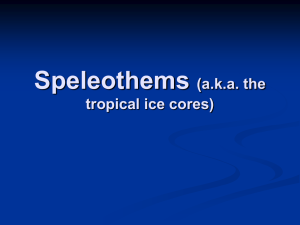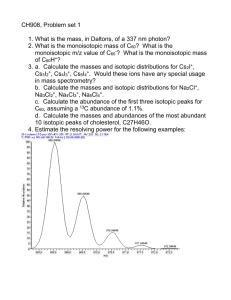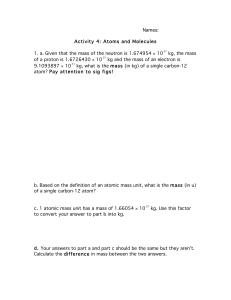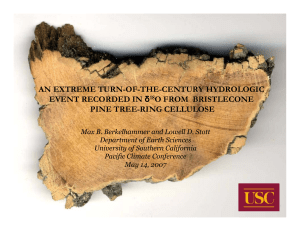Climatic C O in
advertisement
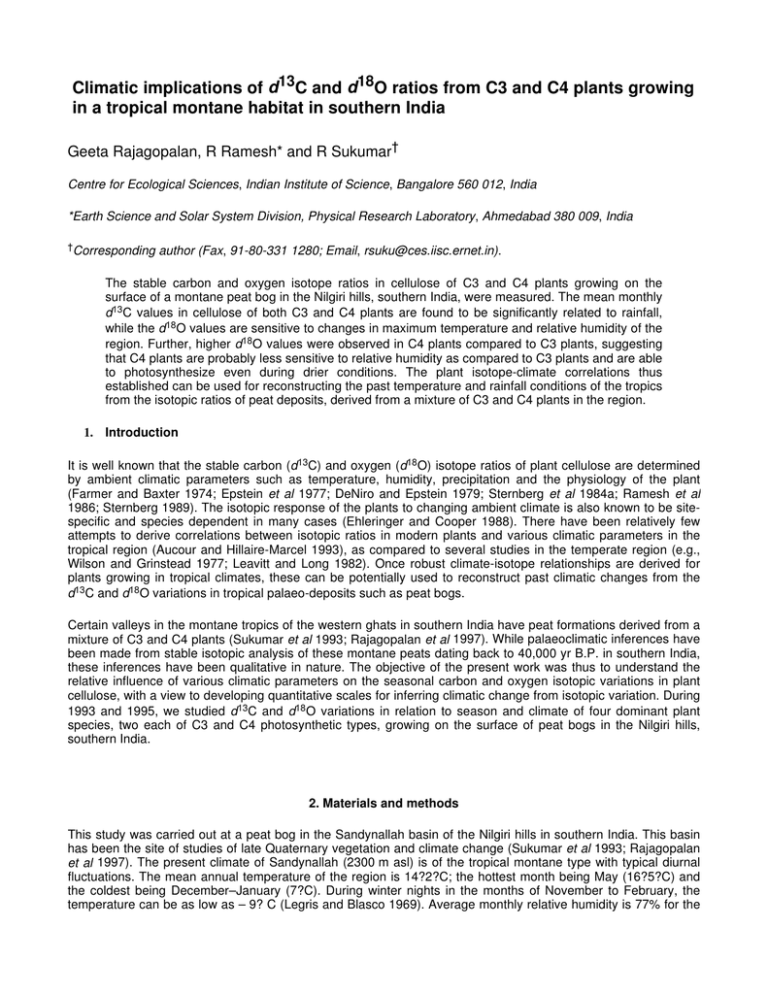
Climatic implications of d13C and d18O ratios from C3 and C4 plants growing in a tropical montane habitat in southern India Geeta Rajagopalan, R Ramesh* and R Sukumar† Centre for Ecological Sciences, Indian Institute of Science, Bangalore 560 012, India *Earth Science and Solar System Division, Physical Research Laboratory, Ahmedabad 380 009, India † Corresponding author (Fax, 91-80-331 1280; Email, rsuku@ces.iisc.ernet.in). The stable carbon and oxygen isotope ratios in cellulose of C3 and C4 plants growing on the surface of a montane peat bog in the Nilgiri hills, southern India, were measured. The mean monthly d13C values in cellulose of both C3 and C4 plants are found to be significantly related to rainfall, while the d18O values are sensitive to changes in maximum temperature and relative humidity of the region. Further, higher d18O values were observed in C4 plants compared to C3 plants, suggesting that C4 plants are probably less sensitive to relative humidity as compared to C3 plants and are able to photosynthesize even during drier conditions. The plant isotope-climate correlations thus established can be used for reconstructing the past temperature and rainfall conditions of the tropics from the isotopic ratios of peat deposits, derived from a mixture of C3 and C4 plants in the region. 1. Introduction It is well known that the stable carbon (d13C) and oxygen (d18O) isotope ratios of plant cellulose are determined by ambient climatic parameters such as temperature, humidity, precipitation and the physiology of the plant (Farmer and Baxter 1974; Epstein et al 1977; DeNiro and Epstein 1979; Sternberg et al 1984a; Ramesh et al 1986; Sternberg 1989). The isotopic response of the plants to changing ambient climate is also known to be sitespecific and species dependent in many cases (Ehleringer and Cooper 1988). There have been relatively few attempts to derive correlations between isotopic ratios in modern plants and various climatic parameters in the tropical region (Aucour and Hillaire-Marcel 1993), as compared to several studies in the temperate region (e.g., Wilson and Grinstead 1977; Leavitt and Long 1982). Once robust climate-isotope relationships are derived for plants growing in tropical climates, these can be potentially used to reconstruct past climatic changes from the d13C and d18O variations in tropical palaeo-deposits such as peat bogs. Certain valleys in the montane tropics of the western ghats in southern India have peat formations derived from a mixture of C3 and C4 plants (Sukumar et al 1993; Rajagopalan et al 1997). While palaeoclimatic inferences have been made from stable isotopic analysis of these montane peats dating back to 40,000 yr B.P. in southern India, these inferences have been qualitative in nature. The objective of the present work was thus to understand the relative influence of various climatic parameters on the seasonal carbon and oxygen isotopic variations in plant cellulose, with a view to developing quantitative scales for inferring climatic change from isotopic variation. During 1993 and 1995, we studied d13C and d18O variations in relation to season and climate of four dominant plant species, two each of C3 and C4 photosynthetic types, growing on the surface of peat bogs in the Nilgiri hills, southern India. 2. Materials and methods This study was carried out at a peat bog in the Sandynallah basin of the Nilgiri hills in southern India. This basin has been the site of studies of late Quaternary vegetation and climate change (Sukumar et al 1993; Rajagopalan et al 1997). The present climate of Sandynallah (2300 m asl) is of the tropical montane type with typical diurnal fluctuations. The mean annual temperature of the region is 14?2?C; the hottest month being May (16?5?C) and the coldest being December–January (7?C). During winter nights in the months of November to February, the temperature can be as low as – 9? C (Legris and Blasco 1969). Average monthly relative humidity is 77% for the Nilgiri hills, with a general high during the monsoon period and low during the dry period. Based on records maintained by the Sandynallah Sheep Breeding Station, the annual cycles in temperature, relative humidity and percentage of annual rainfall of Sandynallah region for the years 1993 and 1995 are indicated in table 1. One limitation of the data on relative humidity is that these were recorded at 08-00 h daily, and may not necessarily correspond to the period of maximum photosynthesis. Monsoon is a dominant climatic feature in the Indian sub-continent. Annual rainfall over the Nilgiri plateau averages about 3000 mm along the western slopes to about 1200 mm in the interior regions (von Lengerke 1977). The south-west monsoon during the months of June to September accounts for more than 80% of total rainfall. The north-east monsoon brings rain during the months of October to December, usually in the form of cyclonic storms. The Sandynallah region receives rainfall from both the monsoon types, with a mean annual rainfall of about 1400 mm. Plants of both C3 and C4 photosynthetic types were collected from the surface of a peat bog in Sandynallah. The collections were carried out during the years 1993 and 1995. Two methods of collection were used. In the year 1993, dominant plants belonging to C3 and C4 types were collected on a seasonal basis from a 3 m ? 3 m permanent plot laid on the surface of the peat bog. The plants were collected during three seasons: (i) Pre-monsoon growth period: During the months of April–May (January to March is usually the dry period) some plant growth can be expected from pre-monsoon rains. The plants were harvested to ground level at the end of the pre-monsoon period. (ii) South-west (summer) monsoon growth period: This comprised of new growth of plants from June to September, which were harvested in the beginning of October. (iii) North-east (winter) monsoon growth period: Fresh growth of plant parts during October–December was harvested by the end of December. In the second phase, plants were collected on a monthly basis from January to December 1995, from the same region. Fresh and newly grown parts from plants were usually collected. Stem portions (in case of sedges) and leaves (in case of herbs and grasses) were collected, identified and thoroughly air-dried for several days for cellulose extraction. The plants were air-dried thoroughly for several days in the field and later dried in an oven at 70? C. The dried plant material was ground to a powder for extracting cellulose. About 500 mg of the material was taken in a beaker with 150 ml distilled water and kept on low heat at 80? C. Delignification was carried out by the method of Green (1963). To the sample about 0?1 ml of ANALAR grade glacial acetic acid was added, followed by 150 mg of pure sodium chlorite. The chlorine dioxide that evolved bleached the sample by removing the lignin. Subsequent additions of acetic acid and sodium chlorite were carried out every hour for 6 h. The white pulp that is obtained after this procedure is holocellulose, which is a mixture of hemicellulose and alpha-cellulose. The holocellulose was filtered using a mesh and washed thoroughly with distilled water. To remove the hemicellulose from the mixture the sample was treated with 17% sodium hydroxide solution for 45 min during which the hemicellulose is dissolved, leaving behind a relatively pure alpha-cellulose. The solution was again filtered and washed with distilled water several times. The cellulose samples were lyophilised and stored in plastic vials for stable isotopic analyses. Carbon isotope ratios of the cellulose samples (and a few dried leaf samples) were measured following the method of Stump and Frazer (1973) using a VG903 mass spectrometer. In the case of d18O analyses of cellulose, the method followed was that of Rittenberg and Ponticarvo (1956) modified by Burk (1979). The isotopic ratios are expressed as d values related to a standard as follows: d13C = [(13C/12C)sample/(13C/12C)standard – 1] ? 1000 d18O = [(18O/16O)sample/(18O/16O)standard – 1] ? 1000. The standard was V-PDB (Vienna Pee Dee Belemnite and V-SMOW (Vienna Standard Mean Ocean Water) for d13C and d18O respectively. The overall reproducibility in the isotopic measurements was ? 0?1‰ for d13C and ? 0?25‰ for d18O. Pearson’s Product Moment Correlation Coefficient R was computed for comparisons between variables and tested for statistical significance at n-2 degrees of freedom from Student’s t distribution. 3. Results 3.1 Stable carbon isotope ratios in C3 and C4 plants During 1995, the d13C values averaged – 26?6‰ (? 2?3, n = 13 species) for C3 herbs (including grasses and sedges) and – 10?9‰ (? 0?97, n = 8 species) for C4 grasses and sedges in the montane region. The four dominant plant species used in this study were Cnicus wallichiana (C3 type; family Asteraceae), Scirpus articulatus (C3 type; family Cyperaceae), Cyperus sp. (C4 type; family Cyperaceae) and Axonopus sp. (C4 type; family Poaceae). The d13C values (figure 1a) in cellulose of C3 species showed an annual variation of 3?6‰ (C. wallichiana) and 2?8‰ (S. articulatus). In general, the seasonal trends of d13C in both the C3 plants are quite similar (R = 0?57, df = 10, P < 0?05). At any given time, the d13C values of C. wallichiana were lower (mean = – 26?8‰) than those of S. articulatus (mean = – 24?3‰). The monthly d13C values in cellulose of the two C4 plant species are shown in figure 1b. The annual ranges of variation are 3?2‰ (Cyperus sp.) and 3?1‰ (Axonopus sp.) which are quite similar. However, the seasonal trends in both the plants are not correlated (R = – 0?48, df = 8, P > 0?05). Further, unlike in the case of the two C3 plants discussed earlier, there is no systematic difference between the monthly d13C values of the two C4 plants. In fact, the difference varies from – 1‰ to 2?5‰. 3.2 Comparison of d13C values in plants with climate The monthly d13C values, obtained for the year 1995 from the four plant species, were compared with the mean monthly climatic data such as mean temperature (T, ? C), maximum temperature (Tmax, ?C), relative humidity (h, %) and rainfall (Rf, mm) collected from the Sandynallah Sheep Breeding Station (see table 1) near the study location. Pearson’s correlations R for the relationship between d13C values and the various climatic parameters are tabulated in table 3. For the significant correlations and those likely to have a physiological basis, linear regressions between the average monthly d13C values of the two C3 plants and one of the C4 plant species (Cyperus sp.) with climatic parameters were carried out. The following relationships were obtained: For C3 plants: (C. wallichiana and S. articulatus) d13C = (– 0?32)T – 21?2 (R = – 0?69, df = 10, P < 0?01) d13C = (– 0?004) Rf – 25?2 (R = – 0?43, df = 10, P > 0?05) For the C4 plant: (Cyperus sp.) d13C = (– 0?37)T – 4?72 (R = – 0?67, df = 10, P < 0?05) d13C = (– 0?007) Rf – 8?98 (R = – 0?64, df = 10, P < 0?05) 3.3 Stable oxygen isotope ratios in C3 and C4 plants Analysis of monthly oxygen isotopic ratios in plants collected during the year 1995 showed an overall range in d18O values from 21‰ to 33‰. The d18O variations of cellulose in the C3 and C4 plants are shown in figure 2. There is no similarity between the seasonal trends in the d18O of the two C3 or the two C4 plant species. The mean d18O values are 25?4‰ and 27?6‰ for the C3 and C4 plants respectively. The two sedges, one (S. articulatus) a C3 plant and the other (Cyperus sp.) a C4 plant showed an average difference in d18O of about 3‰ with the latter showing the higher values. 3.4 Comparison of d18O values in plants with climate The d18O values in cellulose of plants collected during 1993 and 1995 are grouped into three growth periods to enable comparison with climatic parameters (see table 2). The following observations are made: (i) d18O values in plant cellulose of both C3 and C4 photosynthetic types were high (mean of 29?2‰) during the pre-monsoon growth period compared to other periods viz., mean of 25?2‰ for the summer monsoon and 24? 6‰ for the winter monsoon. (ii) High d18O values during the pre-monsoon growth period corresponds to higher Tmax (21?6?C and 20?8?C in 1993 and 1995 respectively) relative to the summer and winter monsoon months, and lower relative humidity (62? 8% and 75?5% for 1993 and 1995, respectively). The correlation values between the monthly d18O values in C3 and C4 plants and climatic parameters during 1995 are shown in table 3. For the significant correlations, which may have a physiological basis, the following regressions were obtained: For C3 plants: (C. wallichiana and S. articulatus) d18O = 1?07 Tmax + 5?47 (R = 0?77, df = 10, P < 0?01) d18O = -0?41 h + 57?7 (R = 0?81, df = 10, P < 0?01) For C4 plants: (Cyperus sp. and Axonopus sp.) d18O = 0?68 Tmax + 14 (R = 0?69, df = 10, P < 0?05) d18O = – 0?52 h + 42?5 (R = – 0?52, df = 10, P < 0?10) 4. Discussion The d13C values of C4 grasses and sedges at the higher elevations (> 2000 m) are higher by an average of about 2‰ as compared to values reported from lower elevations (1000 m) (Sukumar et al 1987). A possible reason for this is that C4 grasses at lower elevations grow on the forest floor, where CO2 respired from trees and shrubs is depleted in 13C. We do not have comparable information for C3 grasses and herbs from the lower elevation. A study by Korner et al (1988) on carbon isotope discrimination in C3 plants, however, also found a similar pattern of increasing 13C content with increasing altitude. They have explained this as the consequence of a lower ratio of internal to external partial pressure of CO2 in leaves of high elevation plants compared to low elevation plants. The difference in the mean d13C values of the two C3 plants growing under similar conditions in the montane habitat can be due to three possible reasons. First, different species are known to have different isotopic fractionations (Leavitt and Long 1989). Second, different photosynthesizing parts of plants show slightly different isotopic values (Long 1982). Hence, the difference could also be partly due to the fact that cellulose from stem portions of S. articulatus and cellulose from leaves of C. wallichiana was used in d13C analyses. Third, the physiognomy of the plants could also be an important factor in explaining the isotopic differences in the two C3 species. C. wallichiana is a rossette type of plant growing at a very low height compared to S. articulatus species. Hence, it is possible that there is an intake of respired CO2 by C. wallichiana from the surrounding plants (Long 1982) and hence it has more depleted d13C values compared to S. articulatus. The d13C values of whole leaves were seen to be more depleted compared to that of cellulose, the mean difference being 1?2 ? 0?8 (n = 4). This could be because the other chemical components, such as lipids, in the leaf are known to be isotopically depleted compared to cellulose (Ramesh 1984). One of the C4 plants (Cyperus sp.) broadly shows seasonal variation in d13C similar to the two C3 plants, even though the correlation is not statistically significant. The other C4 plant (Axonopus sp.), however, shows very different seasonal patterns for which the reasons are unclear. It is interesting to note that the d13C values of C3 and C4 plants yield similar estimates of temperature coefficients (~ 0?35). The intercepts, however, are different by ~ 16‰, which is the difference between the mean d13C values of C3 and C4 plant species in general. It was also found that the coefficients for rainfall were quite similar (~ 0? 005), and the intercepts differed by ~ 16‰ as before, indicating the mean d13C difference in C3 and C4 plants. At Sandynallah, there appears to be a positive correlation between the mean temperature and rainfall (R = 0?51, df = 10, P < 0?10) of the region. Therefore, it is possible that the plant d13C may be responding to only one of the climatic parameters (temperature or rainfall) while the correlation obtained for the other may be due to a parametric relationship between temperature and rainfall. Based on the model developed by Francey and Farquhar (1982), the d13Cp of plant matter is related to d13Ca of the atmospheric CO2, the physical (a) and biological (b) isotopic fractionation factors and Ci/Ca, the ratio of partial pressures of CO2 inside and outside the leaf as follows: d13Cp = d13Ca - a - (b-a)Ci/Ca , Ci/Ca is also related to the CO2 assimilation rate (A) and stomatal conductance (g) by A/g = Ca – Ci . If temperature alone is responsible for the d13C variations in plants, according to this model, when T increases, A will increase, and to minimise water loss, g will decrease thereby reducing Ci/Ca which in turn increases d13Cp. This is in contrast to our empirical negative relationship between d13Cp and T. There is also empirical evidence from other studies that above a certain temperature an increase in T can cause a decrease in A (Schleser 1995). On the other hand, if rainfall alone is responsible for d13Cp variations, from the model it can be seen that while A remains unchanged, g increases with increased rainfall (i.e., increased soil moisture) thereby increasing Ci/Ca and hence reducing d13Cp. This is consistent with our empirical relationship obtained between d13Cp and rainfall of the region. Thus, it appears that one can, in principle, use the d13C values from these plants (and hence peat as it is a mixture of C3 and C4 plants growing in that region) to reconstruct past rainfall variations, although the range of variation may be too small for it to be of practical use. A comparison of d18O values in the two sedge plants, one belonging to the C3 type (S. articulatus) and the other to the C4 type (Cyperus sp.) revealed an interesting difference. The higher d18O value of about 3‰ in the C4 sedge could arise from the fact that a C4 species is able to photosynthesize under dry conditions and is not as sensitive to relative humidity as in the case of C3 species (Sternberg et al 1984b). A comparison of the monthly isotopic ratios in the two plants with climatic factors indicates that, while Scirpus is relatively more sensitive to relative humidity (R = – 0?70, df = 10, P < 0?01), Cyperus is not (R = – 0?21, df = 10, P > 0?05). However, the difference in d18O values of cellulose from C3 and C4 sedges observed in this study is smaller than that reported by Sternberg and DeNiro (1983) and Sternberg et al (1984a, b) which is about 5–8‰. One possible reason could be the smaller sample sizes in our study. However, a similar difference of about 3‰ in the d18O values of cellulose from C3 and C4 sedges has been observed from equatorial swamps (Aucour and Hillaire-Marcel 1993), where, under humid and non-water stressed conditions (as in our study area) the difference in oxygen isotope ratios between C3 and C4 plants is attenuated. It is observed that the average d18O values of both C3 and C4 plants analysed in our study are related to maximum temperature and relative humidity of the region. The temperature coefficient is 1?07‰ for the C3 plants, while it is 0?68‰ for the C4 plants. One possible reason for the difference in temperature coefficients could be because of a species dependence in isotopic fractionation factor. A positive relationship between the d18O values in plant cellulose and maximum temperature is anticipated for the following reasons. (i) d18O of precipitation taken up by the plants is directly proportional to temperature and (ii) higher the temperature, greater is the evaporative enrichment of the heavier isotope of oxygen in the leaf water of plants. In the case of tree-rings, Hughes et al (1982) and Ramesh et al (1986) have found that ring width and isotopic variations in trees are more correlated to mean maximum temperature rather than to mean temperature of the region. The coefficient of relative humidity in the equations we obtained is observed to be negative in both C3 and C4 plants. When relative humidity is high, evaporative enrichment in d18O of plant cellulose can be expected to be lower. The preliminary results obtained from our study are broadly in agreement with earlier findings (Burk and Stuiver 1981; Ramesh et al 1986), where coefficients of – 0?3‰ per % and – 0?19‰ per % have been obtained. The value is close to that obtained by us for the C3 plants (– 0?41‰ per %). At our study site, maximum temperature and relative humidity are negatively correlated (R = – 0?75, df = 10, P < 0?01). It is probable that the isotopic ratios are actually responding to only one climatic factor. Earlier results by Ramesh et al (1986) suggested that the oxygen isotopic ratios in cellulose of tree-rings in Kashmir, are more sensitive to relative humidity than to temperature. It should be noted that the climatic data for the year 1995 in Sandynallah shows much lower variation in relative humidity as compared to maximum temperature. The present study demonstrates that the isotopic ratios in plants in the montane tropics are sensitive to climatic factors. Since these plants contribute to the organic matter of peat deposits, it would be possible to use the isotopic signatures from the peat organic matter for past climatic reconstruction (Sukumar et al 1993; Rajagopalan et al 1997). The carbon isotopic ratios in the C3 and C4 plants are significantly influenced by the rainfall of the region, while the d18O values are sensitive to maximum temperature and relative humidity. Analyses of more species of plants from the region, and covering a wider geographical range to establish the relationship between isotopic ratios in plants and various climatic parameters can provide a firm basis for tropical palaeoclimatology. Acknowledgements This study was partly funded by the Ministry of Environment and Forests, New Delhi. We thank C M Bharanaiah, R Mohan and B Bomma for assistance in sample collection, and the staff of the Sandynallah Sheep Breeding Station, Sandynallah for the meteorological data. We also thank Mr J T Padia for useful suggestions and H S Suresh for assistance. References Aucour A M and Hillaire-Marcel C 1993 A 30,000 year record of 13C and 18O changes in organic matter from an equatorial peat bog; Geophys. Monogr. 78 343–351 Burk R L 1979 Factors affecting oxygen-18/oxygen-16 ratios in cellulose, Ph.D. Thesis, University of Washington, USA Burk R L and Stuiver M 1981 Oxygen isotope ratios in trees reflect mean annual temperature and relative humidity; Science 211 1417 DeNiro M J and Epstein S 1979 Relationship between the oxygen isotope ratios of terrestrial plant cellulose, carbon dioxide and water; Science 204 51–53 Ehleringer J R and Cooper T A 1988 Correlations between carbon isotope ratio and microhabitat in desert plants; Oecologia 76 562– 566 Epstein S, Thompson P and Yapp C J 1977 Oxygen and hydrogen isotopic ratios in plant cellulose; Science 198 1209–1215 Farmer J G and Baxter M S 1974 Atmospheric carbon dioxide levels as indicated by the stable isotopic record in wood; Nature (London) 247 273–275 Francey R J and Farquhar G D 1982 An explanation of 13C/12C variations in tree rings; Nature (London) 297 28–31 Green J W 1963 Wood Cellulose; in Methods in carbohydrate chemistry III (ed.) R L Whistler (New York: Academic Press) p 9 Hughes M K, Kelly P M, Pilcher J R and LaMarche V C 1982 Climate from tree rings (Cambridge: Cambridge University Press) Korner Ch., Farquhar G D and Roksandic Z 1988 A global survey of carbon isotope discrimination in plants from high altitude; Oecologia 74 623–632 Leavitt S W and Long A 1982 Evidence for 13C/12C fractionation between tree leaves and wood; Nature (London) 298 742–744 Leavitt S W and Long A 1989 Intertree variability of d 13C in tree rings; in Stable isotopes in ecological research (eds) P W Rundel, J R Ehleringer and K A Nagy (New York: Springer–Verlag) pp 95–104 Legris P and Blasco F 1969 Variability des facteurs du climat: Cas des montagnes du sud de l’Inde et de Ceylan; Inst. Fr. Pondicherry Tr. Sect. Sci. Tech. 8 1–195 Long A 1982 Stable isotopes in tree rings; in Climate from tree rings (eds) M K Hughes, P M Kelly, J R Pilcher and V C LaMarche (Cambridge: Cambridge University Press) pp 13–18 Rajagopalan G, Sukumar R, Ramesh R, Pant R K and Rajagopalan G 1997 Late Quaternary vegetational and climatic changes from tropical peats in southern India – an extended record up to 40,000 years BP; Curr. Sci. 73 60–63 Ramesh R 1984 Stable isotope systematics in plant cellulose: implications to past climate, Ph.D. Thesis, Gujarat University, Ahmedabad, Gujrat Ramesh R, Bhattacharya S K and Gopalan K 1986 Climatic signatures in the stable isotope records of silver fir (Abies pindrow) trees from Kashmir, India; Earth Planet Sci. Lett. 79 66–74 Rittenberg D and Ponticarvo L 1956 A method for determination of the 18O concentration of the oxygen in organic compounds; Int. J. Appl. Radioact. Isotopes 1 208–214 Schleser G H 1995 Parameters determining carbon isotope ratios in plants; in Problems of stable isotopes in tree-rings, lake sediments and peat-bogs as climatic evidence for the Holocene (eds) B Frenzel, B Stauffer and M M Weib (Stuttgart: Gustav Fischer Verlag) pp 71–95 Sternberg L and DeNiro M J 1983 Isotopic composition of cellulose from C3, C4 and CAM plants growing in the vicinity of one another; Science 220 947–949 Sternberg L, DeNiro M J and Ting I P 1984a Carbon, hydrogen, and oxygen isotope ratios of cellulose from plants having intermediary photosynthetic modes; Plant Physiol. 74 104–107 Sternberg L, DeNiro M J and Johnson H B 1984b Isotopic ratios of cellulose from plants having different photosynthetic pathways; Plant Physiol. 74 557–561 Sternberg L S L 1989 Oxygen and hydrogen isotope ratios in plant cellulose: mechanisms and applications; in Stable isotopes in ecological research (eds) P W Rundel, J R Ehleringer and K A Nagy (New York: Springer-Verlag) pp 124–141 Stump R K and Frazer J W 1973 Simultaneous determination of carbon, hydrogen and nitrogen in organic compounds; Nucl. Sci. Abstr. 28 7848 Sukumar R, Bhattacharya S K and Krishnamurthy R V 1987 Carbon isotopic evidence for different feeding patterns in an Asian elephant population; Curr. Sci. 56 11–14 Sukumar R, Ramesh R, Pant R K and Rajagopalan G 1993 A d 13C record of late Quaternary climate change from tropical peats in southern India; Nature (London) 364 703–706 von Lengerke H J 1977 The Nilgiris: Weather and climate of a mountain area in south India (Wiesbaden: Franz Steiner Verlag) Wilson A T and Grinsted M J 1977 12C/13C in cellulose and lignin as palaeothermometers; Nature (London) 265 133–135 MS received 23 April 1999; accepted 21 October 1999 Corresponding editor: Vidyanand Nanjundiah
